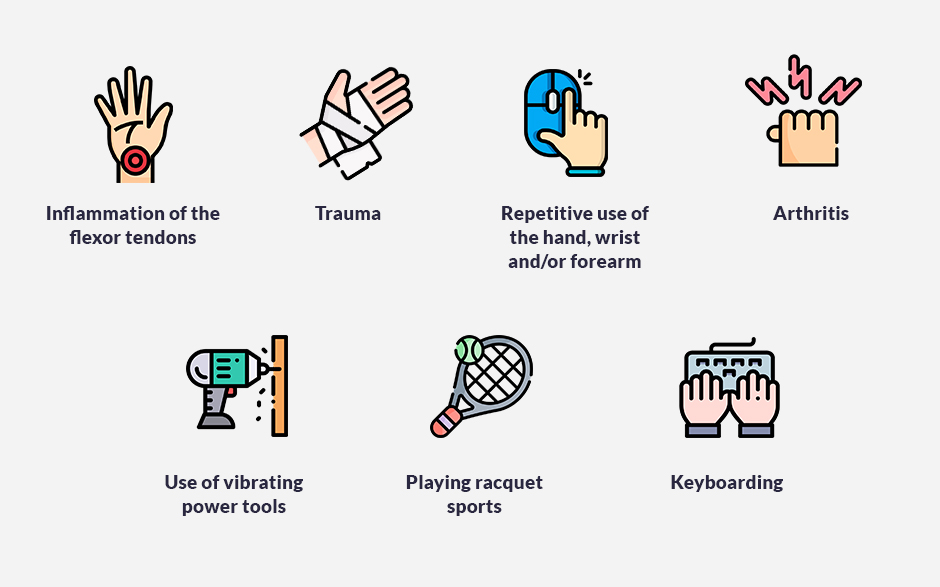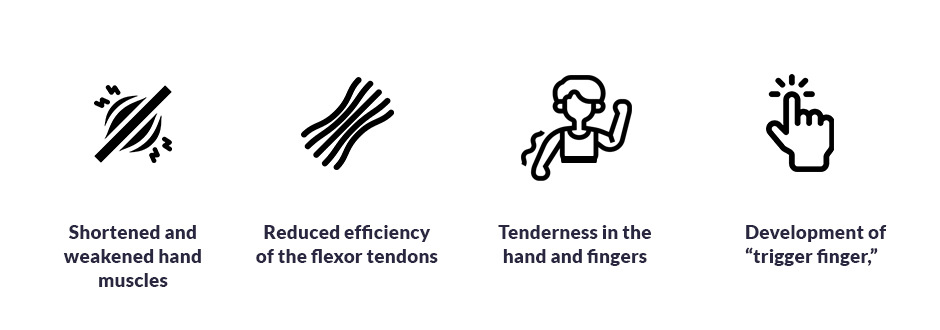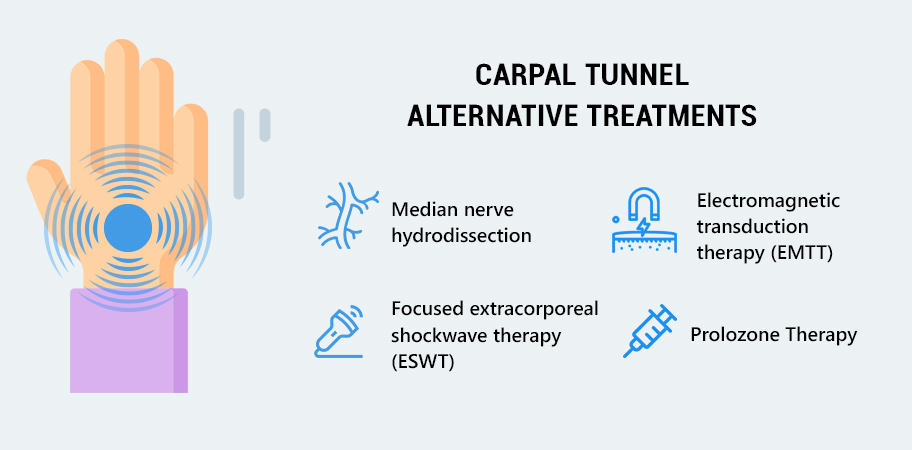
Carpal tunnel syndrome is a painful condition of the wrist and hand that has become increasingly prevalent in the age of technology. Clinically categorized as an entrapment neuropathy, it is estimated that carpal tunnel syndrome affects about five people per 1000, per year in the United States. Carpal tunnel release surgery is often a last-resort solution to persistent carpal tunnel pain. But is it worth the risk?
Carpal tunnel syndrome is brought on by compression of the median nerve, a long nerve that branches from the brachial plexus, a network of nerves in the shoulder region that innervate the muscles in the upper body. The median nerve transmits sensory and motor signals between the spinal cord and the shoulder, arm, forearm and hand.
The carpal tunnel is a narrow passageway near the base of the thumb, formed by the carpal (wrist) bones and the transverse carpal ligament. Those structures form a “tunnel” through which the median nerve travels — along with nine flexor tendons of the hand and forearm — on its way to your hand and fingers.

Carpal tunnel syndrome arises when the median nerve becomes compressed within the tunnel due to one or more various factors, such as:
Inflammation of the flexor tendons
Trauma
Repetitive use of the hand, wrist and/or forearm
Arthritis
Use of vibrating power tools
Playing racquet sports
Keyboarding
In addition, some people have anatomically narrower carpal tunnels — an inherited genetic trait — and prevalence of carpal tunnel often runs in families.

Symptoms of carpal tunnel syndrome include:
Numbness and tingling, especially at night
Numbness while gripping an object
Burning pain in the wrist region
Weakened grip strength
Muscle atrophy in the hand and forearm
Frequently dropping objects
Oftentimes, discontinuing repetitive activities and avoiding overuse of the wrist and hand muscles are enough to resolve symptoms. But for many people with carpal tunnel syndrome, the condition is caused by occupational demands, and abstaining from the activities that provoke it is often not an option.
Most doctors encourage patients to try conservative care before resorting to surgery. But if conservative options do not yield results and the condition becomes debilitating, carpal tunnel release surgery may be suggested as a last resort.
Carpal tunnel release is a fairly common procedure where the surgeon severs the transverse carpal ligament to make more room for the median nerve and flexor tendons. However, while carpal tunnel release may alleviate symptoms, the tradeoff can be carpal instability that interferes with hand and finger function.
Moreover, the carpal tunnel release procedure is not guaranteed to produce the desired results, since compression may occur anywhere along the median nerve’s pathway, from the shoulder all the way down the arm.
Cutting the transverse carpal ligament may produce wrist instability symptoms, along with other adverse outcomes such as:

Shortened and weakened hand muscles
Reduced efficiency of the flexor tendons
Popping or clicking sensations in the fingers
Tenderness in the hand and fingers
Development of “trigger finger,” a condition where a finger is stuck in a bent position, and then suddenly straightens, involuntarily
For people whose occupation requires fine motor hand movements, carpal tunnel release surgery can pose a threat to their livelihood. In addition, carpal tunnel release recovery time can take 3 to 4 months, and it can take up to a full year to restore hand muscle strength.
Carpal tunnel release surgery has been practiced since the 1950s with varying degrees of success. Today, advanced technologies offer conservative alternatives to severing the transverse carpal ligament. Regenerative therapies can dramatically reduce inflammation of the flexor tendons, to make more space in the carpal tunnel. Compared to carpal tunnel release recovery time, regenerative treatments render fast results, with no down time, and without weakening the hand muscles.
Carpal tunnel alternative treatments include:
This procedure uses the patient’s own platelet rich plasma (PRP), injected into the carpal tunnel space around the nerve. PRP’s inherent growth factors serve to break up existing scar tissue, and to improve nerve function by generating new blood vessels and healing nerve tissue.
Shockwave therapy uses high frequency sound waves to disrupt damaged cells. When precisely directed by ultrasound guidance, ESWT reduces inflammation, numbs pain and stimulates tissue repair.

EMTT transmits high energy magnetic pulses that synchronize with the body’s own magnetic fields, causing a disturbance in cells that triggers a regenerative response. EMTT is often used in conjunction with ESWT.
The latest regenerative technologies are game-changers for treating musculoskeletal pain and dysfunction, but they are rarely found in run-of-the-mill physical therapy clinics. The clinic at NYDNRehab features a growing array of technological tools and advanced therapies, to help our patients get the fastest relief possible, with the least amount of discomfort.
Our regenerative therapies set NYDNRehab apart as New York’s premier clinic for injuries, pain syndromes and movement disorders. If you are looking for non-surgical carpal tunnel rehabilitation, contact us today. We offer the fastest and best carpal tunnel syndrome treatment in NYC.
Resource
Ohta, Souichi. “Biomechanical Effects of Transverse Carpal Ligament Release.” Carpal Tunnel Syndrome and Related Median Neuropathies. Springer, Cham, 2017. 245-248.
Dr. Lev Kalika is a world-recognized expert in musculoskeletal medicine. with 20+ years of clinical experience in diagnostic musculoskeletal ultrasonography, rehabilitative sports medicine and conservative orthopedics. In addition to operating his clinical practice in Manhattan, he regularly publishes peer-reviewed research on ultrasound-guided therapies and procedures. He serves as a peer reviewer for Springer Nature.
Dr. Kalika is an esteemed member of multiple professional organizations, including: